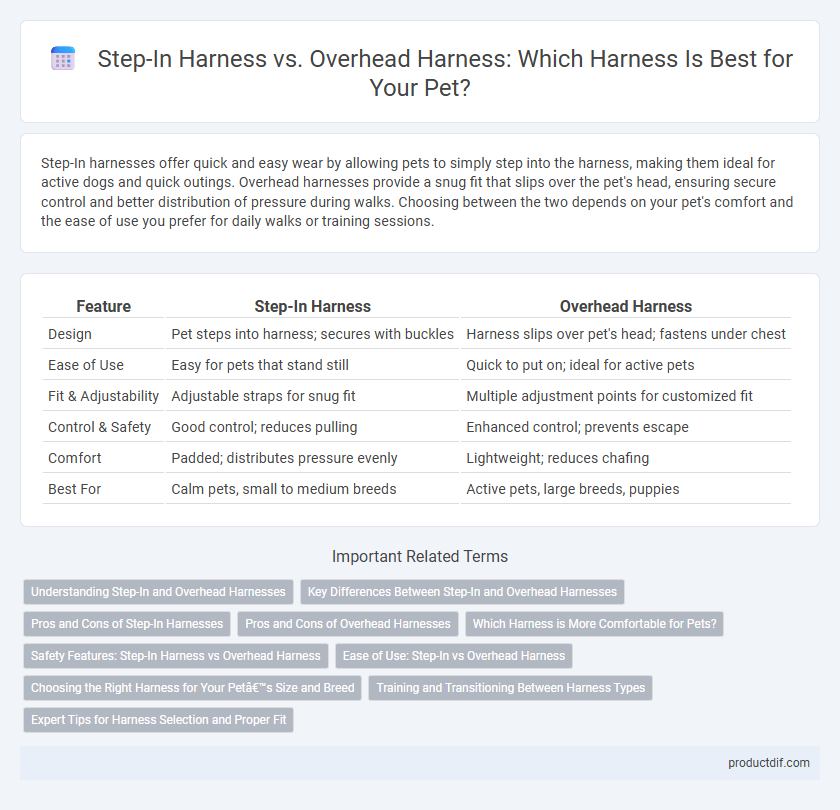Step-In harnesses offer quick and easy wear by allowing pets to simply step into the harness, making them ideal for active dogs and quick outings. Overhead harnesses provide a snug fit that slips over the pet's head, ensuring secure control and better distribution of pressure during walks. Choosing between the two depends on your pet's comfort and the ease of use you prefer for daily walks or training sessions.
Table of Comparison
| Feature | Step-In Harness | Overhead Harness |
|---|---|---|
| Design | Pet steps into harness; secures with buckles | Harness slips over pet's head; fastens under chest |
| Ease of Use | Easy for pets that stand still | Quick to put on; ideal for active pets |
| Fit & Adjustability | Adjustable straps for snug fit | Multiple adjustment points for customized fit |
| Control & Safety | Good control; reduces pulling | Enhanced control; prevents escape |
| Comfort | Padded; distributes pressure evenly | Lightweight; reduces chafing |
| Best For | Calm pets, small to medium breeds | Active pets, large breeds, puppies |
Understanding Step-In and Overhead Harnesses
Step-in harnesses offer easy front-leg entry with quick buckles, ideal for pets that dislike overhead pressure or have mobility issues. Overhead harnesses fit over the pet's head and fasten on the back, providing a secure fit and greater control during walks. Both harness types prioritize comfort and safety, but step-in models often suit anxious or smaller dogs, while overhead harnesses accommodate active or larger breeds.
Key Differences Between Step-In and Overhead Harnesses
Step-in harnesses feature a lower entry point, allowing pets to easily step into the harness, which is ideal for pets with limited mobility or reluctance to raise their legs. Overhead harnesses require the pet's head to pass through a larger opening, providing a snug fit and enhanced control, making them suitable for active or strong chewers. The design differences impact ease of use, comfort, and security, with step-in models prioritizing simplicity and overhead harnesses offering superior restraint.
Pros and Cons of Step-In Harnesses
Step-in harnesses offer easy on-and-off convenience, making them ideal for pets that dislike having harnesses pulled over their heads, and they provide secure positioning to prevent slipping during walks. However, some step-in harnesses may be less adjustable, potentially causing fit issues for active or growing pets, and they might not distribute pressure as evenly as overhead harnesses. These harnesses are often preferred for smaller dogs or those with neck sensitivities due to their comfortable, low-profile design.
Pros and Cons of Overhead Harnesses
Overhead harnesses provide excellent control and security, as they fit snugly over a dog's head and clip around the chest, reducing the risk of slipping out. They are particularly beneficial for dogs with respiratory issues since they avoid pressure on the throat, promoting comfortable breathing during walks. However, overhead harnesses can be difficult to put on dogs that resist having something pulled over their head, and may not offer as much adjustability as step-in harnesses for varying body shapes.
Which Harness is More Comfortable for Pets?
Step-in harnesses are often preferred for pets with limited mobility or anxiety because they are easier to put on and provide even pressure distribution across the chest, reducing strain on the neck. Overhead harnesses, while secure, can sometimes cause discomfort if not properly fitted, as the straps pass over the head and may tighten during movement. Comfort depends heavily on fit, material quality, and pet behavior, making the step-in harness generally more comfortable for sensitive pets or those with respiratory issues.
Safety Features: Step-In Harness vs Overhead Harness
Step-in harnesses provide secure and snug fit by wrapping around the chest and shoulders, reducing the risk of escape during walks. Overhead harnesses feature adjustable straps and sturdy buckles designed for easy on-and-off while maintaining safety and control. Both harness types offer reflective stitching or padding options to enhance visibility during low-light conditions, improving overall pet safety.
Ease of Use: Step-In vs Overhead Harness
Step-In harnesses offer quicker and simpler application for dogs, requiring the pet to step into the openings before securing the straps, making them ideal for pets that resist overhead placement. Overhead harnesses involve slipping the harness over the dog's head, which can be more challenging for pets with limited head mobility or anxiety. Both types feature adjustable straps for a snug fit, but Step-In designs generally reduce preparation time and effort during daily walks.
Choosing the Right Harness for Your Pet’s Size and Breed
Selecting the right harness for your pet depends heavily on their size and breed to ensure comfort and control. Step-in harnesses are ideal for smaller or shorter-coated pets, providing easy wear and even distribution of pressure across the chest. Overhead harnesses suit larger or more active breeds, offering adjustable features and a secure fit that prevents slipping during vigorous activities.
Training and Transitioning Between Harness Types
Step-in harnesses offer a straightforward design that makes initial training easier for puppies and dogs new to harnesses by reducing the complexity of putting it on. Overhead harnesses provide more control and security, ideal for advanced training and dogs prone to pulling. Transitioning between harness types requires gradual acclimation, rewarding positive behavior to ensure comfort and prevent resistance during walks.
Expert Tips for Harness Selection and Proper Fit
Step-in harnesses provide easy wearability suited for dogs with limited neck mobility, while overhead harnesses offer adjustable fit and better control for active pets. Experts recommend prioritizing harnesses with padded straps and multiple adjustment points to prevent chafing and ensure even pressure distribution during walks. Proper fit involves snug placement around the chest and shoulders without restricting movement or breathing, verified by the two-finger rule to maintain comfort and safety.
Step-In Harness vs Overhead Harness Infographic

 productdif.com
productdif.com